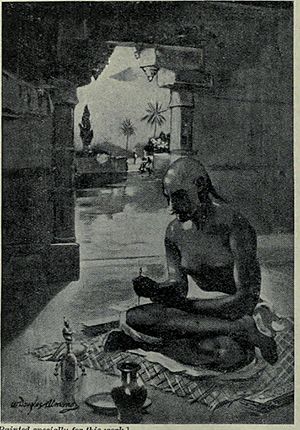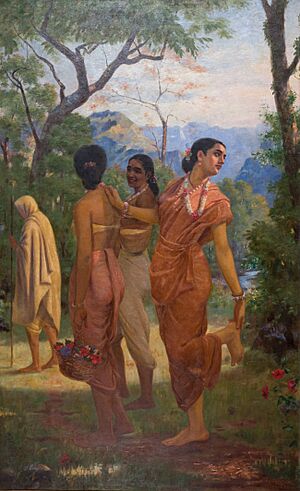Kalidasa facts for kids
Quick facts for kids
Kalidasa
|
|
|---|---|

A 20th-century artist's impression of Kālidāsa composing the Meghadūta
|
|
| Occupation | Poet, Dramatist |
| Language | Sanskrit, Prakrit |
| Period | c. 4th–5th century CE |
| Genre | Sanskrit drama, Classical literature |
| Subject | Epic poetry, Puranas |
| Notable works | Kumārasambhavam, Abhijñānaśākuntalam, Raghuvaṃśa, Meghadūta, Vikramōrvaśīyam |
Kālidāsa was an amazing writer from ancient India. He is often called India's greatest poet and playwright. His stories and poems are mostly based on old Indian texts like the Vedas, the Rāmāyaṇa, the Mahābhārata, and the Purāṇas. We know he wrote three plays, two long poems (epic poems), and two shorter poems that are still around today.
We don't know much about Kālidāsa's life, only what we can guess from his writings. We also don't know exactly when he lived, but it was probably before the 5th century CE.
Contents
Where Did Kālidāsa Live?
Scholars have different ideas about where Kālidāsa might have lived. Some think he lived near the Himalayas, or in a city called Ujjain, or in a region called Kalinga.
These ideas come from his writings:
- He described the Himalayas in great detail in his poem Kumārasambhava.
- He showed a lot of love for Ujjain in his poem Meghadūta.
- He praised the Kalinga emperor Hemāngada in his poem Raghuvaṃśa.
A scholar named Lakshmi Dhar Kalla thought Kālidāsa was born in Kashmir. He believed Kālidāsa later moved south to find support from local rulers. Kalla found clues in Kālidāsa's writings, such as:
- Descriptions of plants and animals found in Kashmir, like saffron and deodar trees.
- Descriptions of places like tarns (small mountain lakes) and glades (open spaces in forests), which are common in Kashmir.
- Mentions of local Kashmiri legends, like the story of Kashmir being created from a lake.
There's also an old story that says Kālidāsa visited the king of Lanka and was sadly murdered there.
When Did Kālidāsa Live?
Many old books say that Kālidāsa was a poet in the court of a king named Vikramāditya. A famous legendary king named Vikramāditya is said to have ruled from Ujjain around 1st century BCE. However, some scholars think this legendary king might not have been a real person.
Other kings who ruled from Ujjain also used the title Vikramāditya. The most famous ones were Chandragupta II (who ruled from 380 CE to 415 CE) and Yaśodharman (who ruled in the 6th century CE).
The most popular idea is that Kālidāsa lived during the time of Chandragupta II, which means he lived around the 4th or 5th century CE. Many scholars, both Western and Indian, support this idea. His career might have continued into the reigns of Kumāragupta I and Skandagupta.
The earliest proof of Kālidāsa's existence is found in an old Sanskrit writing from about 473 CE. It has verses that seem to copy his style. His name is first clearly mentioned in a writing from 634 CE found in Karnataka.
Kālidāsa's Amazing Works
His Poems
Epic Poems
Kālidāsa wrote two long epic poems, which are called mahākāvyas:
- Kumārasambhava: This poem tells the story of the birth and childhood of the goddess Pārvatī. It also describes her marriage to the god Śiva and the birth of their son, Kumāra (also known as Kārtikeya).
- Raghuvaṃśa (meaning "Dynasty of Raghu"): This epic poem is about the kings of the Raghu dynasty, a famous royal family.
Shorter Poems
Kālidāsa also wrote a beautiful shorter poem called Meghadūta (The Cloud Messenger). It tells the story of a Yakṣa (a nature spirit) who is trying to send a message to his loved one through a cloud. This poem is known for its sweet and musical language. It's one of Kālidāsa's most loved poems, and many people have written explanations about it.
He also wrote the Shyamala Dandakam, which describes the beauty of the Goddess Matangi.
His Plays
Kālidāsa wrote three plays. Among them, Abhijñānaśākuntalam ("Of the recognition of Śakuntalā") is thought to be his greatest work. It was one of the first Sanskrit works to be translated into English and has since been translated into many other languages around the world.
- Mālavikāgnimitram (Pertaining to Mālavikā and Agnimitra): This play is about King Agnimitra who falls in love with a picture of a servant girl named Mālavikā. His queen gets angry when she finds out, and Mālavikā is put in prison. But it turns out Mālavikā is actually a princess, which makes their love story acceptable.
- Abhijñānaśākuntalam (Of the recognition of Śakuntalā): This play tells the story of King Duṣyanta. While hunting, he meets Śakuntalā, who was raised by a sage. They fall in love and get married. A problem happens when Duṣyanta is called back to his kingdom. Śakuntalā, who is expecting their child, accidentally upsets a wise man named Durvasa. He curses her, making Duṣyanta forget her completely unless he sees the ring he gave her. Later, Śakuntalā loses the ring, and Duṣyanta doesn't recognize her. A fisherman finds the ring, and when Duṣyanta sees it, his memory returns. He then goes to find Śakuntalā. The famous German writer Goethe was very impressed by this play.
- Vikramōrvaśīyam (Ūrvaśī Won by Valour): This play is about King Pururavas and a heavenly dancer named Ūrvaśī who fall in love. Because she is immortal, she has to go back to heaven. But an accident causes her to be sent back to Earth as a human. She is cursed to return to heaven the moment her lover sees the child she will have. After some adventures, including Ūrvaśī turning into a plant for a while, the curse is lifted, and they can stay together on Earth.
Translations of His Works
Many of Kālidāsa's plays and poems have been translated. Sir William Jones published an English translation of Śakuntalā in 1791 CE.
Kālidāsa's Influence
Kālidāsa had a huge impact on many Sanskrit writings and all Indian literature. He also greatly influenced the famous Indian poet Rabindranath Tagore. The romantic style of Meghadūta can be seen in Tagore's poems about the monsoon season. Kālidāsa's plays also influenced European literature in the late 1700s and early 1800s.
Why He Is So Famous
Bāṇabhaṭṭa, a writer from the 7th century CE, wrote that everyone loved Kālidāsa's sweet and charming sayings. Later, another poet named Jayadeva called Kālidāsa "the lord of poets."
Kālidāsa is often called the Shakespeare of India. The scholar Sir William Jones was one of the first to make this comparison. Many people agree that comparing Kālidāsa to Shakespeare is one of the highest compliments he could receive.
The scholar Monier Williams wrote that Kālidāsa's works show his amazing poetic talent, his rich imagination, and his deep understanding of human feelings. He said Kālidāsa truly deserves to be called the Shakespeare of India.
Kālidāsa in Later Culture
Many scholars have written explanations and notes about Kālidāsa's works. Some of the most studied ones were written by Mallinātha Sūri in the 15th century.
Kālidāsa's play Abhijñānaśākuntalam was one of the first Indian books to become well-known in Europe. It was translated into English, and then from English into German. Famous German poets like Herder and Goethe were amazed by it.
Kālidāsa's work continued to inspire artists in Europe in the late 1800s and early 1900s. For example, the sculptor Camille Claudel created a sculpture called Shakuntala.
Many films have been made based on Kālidāsa's life and works:
- The Kannada films Mahakavi Kalidasa (1955) and Kaviratna Kalidasa (1983) were about his life.
- The Hindi movie Stree (1961) was based on his play Shakuntala.
- The Tamil movie Mahakavi Kalidas (1966) featured the actor Sivaji Ganesan playing Kālidāsa.
- The Telugu film Mahakavi Kalidasu (1960) also focused on his life and work.
There are also plays about Kālidāsa. Athavan Sarga (1976) is a Hindi play based on a legend that Kālidāsa couldn't finish one of his poems because a goddess cursed him. Another Sanskrit play, Asti Kashchid Vagarthiyam (1984), tells a popular story that Kālidāsa was once not very smart, and his wife helped him become a great scholar and poet.
See also
 In Spanish: Kalidasa para niños
In Spanish: Kalidasa para niños
- Sanskrit literature
- Sanskrit drama
- Bhāsa
- Bhavabhūti


